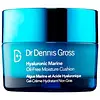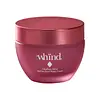What's inside
What's inside
 Key Ingredients
Key Ingredients

 Benefits
Benefits

 Concerns
Concerns

 Ingredients Side-by-side
Ingredients Side-by-side

Water
Skin ConditioningCetearyl Alcohol
EmollientC13-16 Isoparaffin
SolventStearyl Dimethicone
EmollientDimethicone
EmollientButylene Glycol
HumectantCaprylic/Capric Triglyceride
MaskingGlyceryl Behenate
EmollientSodium Hyaluronate
HumectantCaulerpa Lentillifera Extract
Saccharide Isomerate
HumectantAloe Barbadensis Leaf Extract
EmollientTocopherol
AntioxidantCitrullus Lanatus Fruit Extract
Skin ConditioningCocos Nucifera Fruit Extract
EmollientCitrus Sinensis Fruit Extract
AntioxidantVaccinium Myrtillus Fruit/Leaf Extract
AstringentLactic Acid
BufferingGlycolic Acid
BufferingSaccharum Officinarum Extract
MoisturisingLeuconostoc/Radish Root Ferment Filtrate
AntimicrobialCitrus Aurantium Dulcis Fruit Extract
MaskingCitrus Limon Fruit Extract
MaskingAcer Saccharum Extract
Skin ConditioningCollagen Amino Acids
MoisturisingAdenosine
Skin ConditioningHydrolyzed Soy Protein
HumectantCopper PCA
HumectantIsohexadecane
EmollientHeptyl Undecylenate
EmollientEthylhexylglycerin
Skin ConditioningDimethicone Crosspolymer-3
Skin ConditioningIsododecane
EmollientOctadecene
SolventSodium Acrylate/Sodium Acryloyldimethyl Taurate Copolymer
Emulsion StabilisingPotassium Cetyl Phosphate
EmulsifyingSorbitan Oleate
EmulsifyingCeteareth-20
CleansingPolysorbate 80
EmulsifyingSodium Citrate
BufferingCitric Acid
BufferingBenzyl Alcohol
PerfumingPhenoxyethanol
PreservativeSodium Benzoate
MaskingPotassium Sorbate
PreservativeWater, Cetearyl Alcohol, C13-16 Isoparaffin, Stearyl Dimethicone, Dimethicone, Butylene Glycol, Caprylic/Capric Triglyceride, Glyceryl Behenate, Sodium Hyaluronate, Caulerpa Lentillifera Extract, Saccharide Isomerate, Aloe Barbadensis Leaf Extract, Tocopherol, Citrullus Lanatus Fruit Extract, Cocos Nucifera Fruit Extract, Citrus Sinensis Fruit Extract, Vaccinium Myrtillus Fruit/Leaf Extract, Lactic Acid, Glycolic Acid, Saccharum Officinarum Extract, Leuconostoc/Radish Root Ferment Filtrate, Citrus Aurantium Dulcis Fruit Extract, Citrus Limon Fruit Extract, Acer Saccharum Extract, Collagen Amino Acids, Adenosine, Hydrolyzed Soy Protein, Copper PCA, Isohexadecane, Heptyl Undecylenate, Ethylhexylglycerin, Dimethicone Crosspolymer-3, Isododecane, Octadecene, Sodium Acrylate/Sodium Acryloyldimethyl Taurate Copolymer, Potassium Cetyl Phosphate, Sorbitan Oleate, Ceteareth-20, Polysorbate 80, Sodium Citrate, Citric Acid, Benzyl Alcohol, Phenoxyethanol, Sodium Benzoate, Potassium Sorbate
Water
Skin ConditioningDimethicone
EmollientGlycerin
HumectantButylene Glycol
HumectantSaccharide Isomerate
HumectantDimethicone/PEG-10/15 Crosspolymer
Sodium Chloride
MaskingHydroxyacetophenone
AntioxidantPEG-10 Dimethicone
Skin ConditioningPanthenol
Skin ConditioningDimethicone/Vinyl Dimethicone Crosspolymer
Skin ConditioningCaprylic/Capric Triglyceride
MaskingParfum
MaskingSodium Citrate
BufferingCitric Acid
BufferingSodium Hyaluronate
HumectantPropanediol
SolventDipropylene Glycol
HumectantSalicornia Herbacea Extract
Skin ConditioningOpuntia Ficus-Indica Stem Extract
Skin ConditioningDisodium Phosphate
BufferingXanthan Gum
EmulsifyingSodium Phosphate
BufferingTocopherol
AntioxidantSodium Benzoate
MaskingGlyceryl Caprylate
EmollientPentylene Glycol
Skin ConditioningOpuntia Ficus-Indica Callus Culture Extract
AntioxidantAloe Barbadensis Leaf Extract
EmollientCI 17200
Cosmetic ColorantCitronellol
PerfumingGeraniol
PerfumingWater, Dimethicone, Glycerin, Butylene Glycol, Saccharide Isomerate, Dimethicone/PEG-10/15 Crosspolymer, Sodium Chloride, Hydroxyacetophenone, PEG-10 Dimethicone, Panthenol, Dimethicone/Vinyl Dimethicone Crosspolymer, Caprylic/Capric Triglyceride, Parfum, Sodium Citrate, Citric Acid, Sodium Hyaluronate, Propanediol, Dipropylene Glycol, Salicornia Herbacea Extract, Opuntia Ficus-Indica Stem Extract, Disodium Phosphate, Xanthan Gum, Sodium Phosphate, Tocopherol, Sodium Benzoate, Glyceryl Caprylate, Pentylene Glycol, Opuntia Ficus-Indica Callus Culture Extract, Aloe Barbadensis Leaf Extract, CI 17200, Citronellol, Geraniol
Ingredients Explained
These ingredients are found in both products.
Ingredients higher up in an ingredient list are typically present in a larger amount.
Aloe Barbadensis Leaf Extract is an extract of the leaves of the aloe, Aloe barbadensis, Liliaceae.
Aloe is one of the most well-known natural soothing ingredients, and for good reason. It’s full of water and has a cooling, calming effect on the skin, especially when it’s sunburned, itchy, or irritated. Aloe also helps your skin stay hydrated and smooth by mimicking what healthy skin naturally produces. On top of that, it contains vitamins and nutrients that support skin recovery.
It doesn’t protect you from the sun, but it can help your skin bounce back after too much time in it.
Let’s get into the details:
Aloe contains antioxidant Vitamins A, C, and E, which help fight off free radicals (unstable molecules from things like pollution that can damage your skin).
It’s also rich in polysaccharides, which are natural sugars that help hydrate the skin by acting like the skin’s own moisturizing agents. These, along with other sugars like monosaccharides, help form a protective barrier that locks in moisture.
Aloe works as both a humectant and an emollient. That means it draws water into the skin (humectant) and helps trap it there (emollient), making it an effective natural moisturizer.
You’ll also find a mix of other skin-supporting ingredients in aloe, including folic acid, choline, calcium, amino acids, fatty acids, and even Vitamin B12.
Out of the 420+ species of aloe, Aloe barbadensis is the most widely used in skincare products thanks to its gentle yet effective properties.
There are over 420 species of aloe but Aloe Barbadensis is the most commonly used for topical products.
Learn more about Aloe Barbadensis Leaf ExtractButylene Glycol (or BG) is used within cosmetic products for a few different reasons:
Overall, Butylene Glycol is a safe and well-rounded ingredient that works well with other ingredients.
Though this ingredient works well with most skin types, some people with sensitive skin may experience a reaction such as allergic rashes, closed comedones, or itchiness.
Learn more about Butylene GlycolThis ingredient is an emollient, solvent, and texture enhancer. It is considered a skin-softener by helping the skin prevent moisture loss.
It helps thicken a product's formula and makes it easier to spread by dissolving clumping compounds.
Caprylic Triglyceride is made by combining glycerin with coconut oil, forming a clear liquid.
While there is an assumption Caprylic Triglyceride can clog pores due to it being derived from coconut oil, there is no research supporting this.
Learn more about Caprylic/Capric TriglycerideCitric Acid is an alpha hydroxy acid (AHA) naturally found in citrus fruits like oranges, lemons, and limes.
Like other AHAs, citric acid can exfoliate skin by breaking down the bonds that hold dead skin cells together. This helps reveal smoother and brighter skin underneath.
However, this exfoliating effect only happens at high concentrations (20%) which can be hard to find in cosmetic products.
Due to this, citric acid is usually included in small amounts as a pH adjuster. This helps keep products slightly more acidic and compatible with skin's natural pH.
In skincare formulas, citric acid can:
While it can provide some skin benefits, research shows lactic acid and glycolic acid are generally more effective and less irritating exfoliants.
Most citric acid used in skincare today is made by fermenting sugars (usually from molasses). This synthetic version is identical to the natural citrus form but easier to stabilize and use in formulations.
Read more about some other popular AHA's here:
Learn more about Citric AcidDimethicone is a type of synthetic silicone created from natural materials such as quartz.
What it does:
Dimethicone comes in different viscosities:
Depending on the viscosity, dimethicone has different properties.
Ingredients lists don't always show which type is used, so we recommend reaching out to the brand if you have questions about the viscosity.
This ingredient is unlikely to cause irritation because it does not get absorbed into skin. However, people with silicone allergies should be careful about using this ingredient.
Note: Dimethicone may contribute to pilling. This is because it is not oil or water soluble, so pilling may occur when layered with products. When mixed with heavy oils in a formula, the outcome is also quite greasy.
Learn more about DimethiconeSaccharide Isomerate comes from sugars found in corn. It is a skin hydrator.
The structure of this ingredient can be altered to be more similar to the carbohydrates found in our skin. This ability to mimic our skin gives it hydrating properties.
Specifically, saccharide Isomerate is a humectant. Humectants draw moisture from the air to our skin.
Research shows Saccharide Isomerate to be an effective moisturizer.
Learn more about Saccharide IsomerateSodium Benzoate is a preservative. It's used in both cosmetic and food products to inhibit the growth of mold and bacteria. It is typically produced synthetically.
Both the US FDA and EU Health Committee have approved the use of sodium benzoate. In the US, levels of 0.1% (of the total product) are allowed.
Sodium benzoate works as a preservative by inhibiting the growth of bacteria inside of cells. It prevents the cell from fermenting a type of sugar using an enzyme called phosphofructokinase.
It is the salt of benzoic acid. Foods containing sodium benzoate include soda, salad dressings, condiments, fruit juices, wines, and snack foods.
Studies for using ascorbic acid and sodium benzoate in cosmetics are lacking, especially in skincare routines with multiple steps.
We always recommend speaking with a professional, such as a dermatologist, if you have any concerns.
Learn more about Sodium BenzoateSodium Citrate is the sodium salts of citric acid. In skincare, it is used to alter pH levels and acts as a preservative.
Its main functions are to maintain the pH of a product and neutralize metal ions.
The acidity of our skin is maintained by our glands and skin biome; normal pH level of skin is slightly acidic (~4.75-5.5).
Being slightly acidic allows our skin to create an "acid mantle". This acid mantle is a thin barrier that protects our skin from bacteria and contaminants.
Learn more about Sodium CitrateSodium Hyaluronate is hyaluronic acid's salt form. It is commonly derived from the sodium salt of hyaluronic acid.
Like hyaluronic acid, it is great at holding water and acts as a humectant. This makes it a great skin hydrating ingredient.
Sodium Hyaluronate is naturally occurring in our bodies and is mostly found in eye fluid and joints.
These are some other common types of Hyaluronic Acid:
Learn more about Sodium HyaluronateTocopherol (also known as Vitamin E) is a common antioxidant used to help protect the skin from free-radicals and strengthen the skin barrier. It's also fat soluble - this means our skin is great at absorbing it.
Vitamin E also helps keep your natural skin lipids healthy. Your lipid skin barrier naturally consists of lipids, ceramides, and fatty acids. Vitamin E offers extra protection for your skin’s lipid barrier, keeping your skin healthy and nourished.
Another benefit is a bit of UV protection. Vitamin E helps reduce the damage caused by UVB rays. (It should not replace your sunscreen). Combining it with Vitamin C can decrease sunburned cells and hyperpigmentation after UV exposure.
You might have noticed Vitamin E + C often paired together. This is because it is great at stabilizing Vitamin C. Using the two together helps increase the effectiveness of both ingredients.
There are often claims that Vitamin E can reduce/prevent scarring, but these claims haven't been confirmed by scientific research.
Learn more about TocopherolWater. It's the most common cosmetic ingredient of all. You'll usually see it at the top of ingredient lists, meaning that it makes up the largest part of the product.
So why is it so popular? Water most often acts as a solvent - this means that it helps dissolve other ingredients into the formulation.
You'll also recognize water as that liquid we all need to stay alive. If you see this, drink a glass of water. Stay hydrated!
Learn more about Water